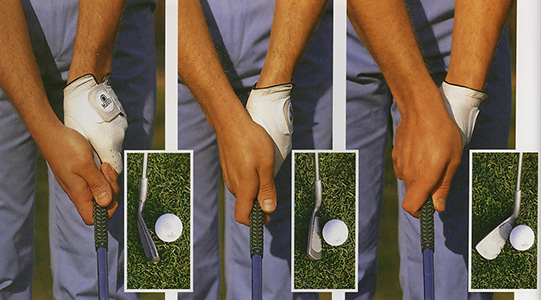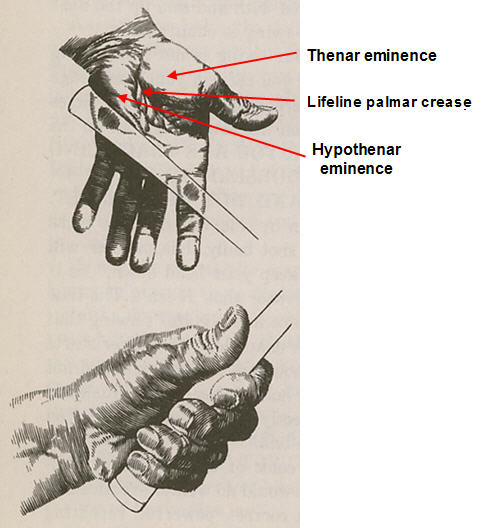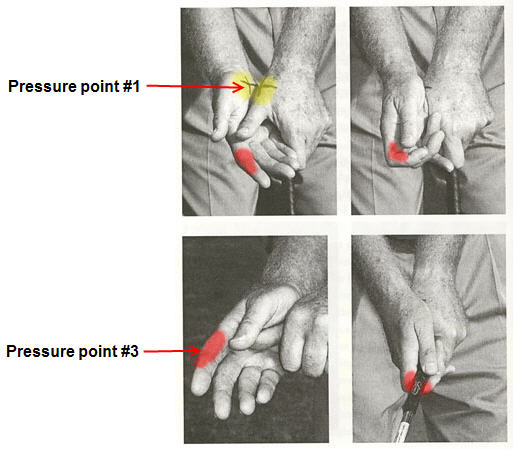The first thing I want to note is that the grip is a fundamental part of the golf the swing. Note that this is singular, but not exclusive. If you asked most people 'what are the fundamentals of the golf swing' they will inevitably tell you that it is your address position and grip. Not that they are wrong in the sense that address and grip are fundamentals of the swing, but there are plenty of other fundamentals, like hitting the ball first, then taking a divot...a FLW at impact...straight plane lines...proper lag pressure usage...hinge action...proper downswing sequence (power accumulator sequence)...lagging the clubhead on the downswing...low point control...clubface control, and probably a few others that slip my mind at the moment.
That's why I started these 'key concepts' with looking at things like low point control, clubface control, steep enough attack angles, etc. because I wanted those things that are often ignored to be on the forefront. The grip is undoubtedly very important, but you can have the textbook grip and if you don't accomplish those other key concepts I've mentioned very well, then you'll never break 80. And more often that not, you'll find that in order to make serious improvements to your swing, it usually goes beyond the grip and address position. However, if you start struggling, it's always smart to look at the grip and address position as you may have fallen into some bad habits and that may be causing the problems from the get-go.
When it comes to the grip, most people focus on the 'style' of grip, whether it be 'strong', 'neutral' or 'weak.' The photo below, provided by Jeff Mann shows a 'strong', 'neutral' and 'weak' grip.

The nice part of this photo is that it shows (in a bit of an exagerrated form) what each grip tends to cause. A strong grip tends to cause a closed clubface. A weak grip tends to cause an open clubface.
Now, that certainly doesn't mean that you cannot play with either, in fact you may want to switch to one or the other depending on the type of shot you hit. Remember the Part IV of this series where I discussed the ball flight laws. If you are hitting a hook, you may want to weaken your grip so you can get the ball flight moving a little more to the right initially and allowing the ball to draw back to the target. This is *one* of the many things that Ben Hogan did to eliminate his snap hook. Conversely, if you have a slice, you may want to go to a strong grip to close the clubface a little more and allow the ball to start out a little more to the left and then fade back to the target.
Most people look at their grip as 'how many knuckles in your left hand are visible' and they usually want no more than 3, and more like 2 knuckles showing (usually the index and middle knuckles) and leave it at that. But, there's a lot more to it that just that.
One key point here is where the golf grip should lay in the left hand. This diagram from Hogan's book '5 Lessons' shows the correct way to grip the club with the left hand.

Now, you can have a strong, weak or neutral grip, just make sure that the club is held in that position of the left hand. If you want a strong grip, just rotate the hand more away from the target. Weaker grips rotate the hand more toward the target.
This again is very key, because many golfers just see that they are only showing 2 knuckles and have a Vardon grip and think they are good to go. But in reality they have a very poor grip because they don't have the club gripped correctly in the left hand.
As far as the 'type' of grip (interlocking, 10 finger, Vardon) there's a general assumption that you *must* have a Vardon grip in order to play good golf. I find that to be wildly untrue. Tiger and Nicklaus both played with interlocking grips. Moe Norman used a 10 finger grip from time to time and Bob Estes uses it as well. Steve Jones won the US Open with a reverse overlap grip. Jim Furyk actually uses a double overlap.

Because I hold the golf swing to be a very customizable process, I also have to hold that no one grip type is the way to go. In fact, I highly suggest that you spend about 10 minutes on the range experimenting with each grip type if you haven't done so in a long time. You may find that you hit the ball better with a 10 finger grip than a Vardon grip. However, I will say that the 10 finger grip is probably better for golfers with small hands as bigger hands tend to over-rotate the clubface with the 10 finger grip. Conversely, the Vardon Grip is probably a bit better for bigger hands. The interlocking grip is probably somewhere between.
BIG MISCONCEPTION BREAKER
One of the biggest misconceptions about the swing, in particular the grip is how tight the golfer should grip the club. The old saying to the effect is that you should feel like you are gripping the club as tight as you would to 'hold a bird, tight enought to not let it fly away, light enough to not kill the bird.' That saying was coined by Sam Snead who also had gigantic hands that were very strong. In other words, gripping tight for most golfers would be gripping rather lightly for somebody with Snead's hands.
One can think of grip tightness a bit like throwing a baseball. In baseball if you are looking to throw a fastball, you loosen up the grip as much as you can. If you want to throw a changeup, which is the same motion as the fastball, but comes out noticeably slower...you want to tighten up the grip. The same applies with hitting a ball. If I want to hit the ball further, I'll lighten up on the grip. If I want more control, then I actually grip tighter to control the clubface better. Tiger Woods has even said that in his grip he feels on a scale of 1-10 he grips it at about a 7-8, much harder than Snead prescribed.
GRIP PRESSURE POINTS
There are 3 pressure points in the grip that most golfers have zero clue about.
Here are the #1 and #3 Pressure Points.

The #2 Pressure Point is the last 3 fingers (pinky, ring and middle fingers) of the *left* hand. They were labeled as #1-#3 by Homer Kelley in his book 'The Golfing Machine.'
Golfers that 'push' the club (aka hitters) will use the #1 and #3 PP most of the time. Golfers that 'pull' the club (aka swingers) will use the #2 PP most of the time. You can actually use all 3 if you like.
I suggest that you be able to sense them when you address the ball. And a good drill is to grip the club and concentrate on one of the PP's and just feel like you are up to, on a scale of 1-10, a 10 with pressure on that pressure point. Then go to a 5 level of pressure. Then move onto the next pressure point and do the same.
The one thing I would suggest with this, as well as grip tightness, is that you don't want any 'loose ends' when it comes to the grip. I feel like my grips are 'sealed air tight.' I hear many golfers feel like their hands are like clamps to the golf club. Again, part of it is getting all the pressure points down but also having to grip the club much tighter than you usually do. You would be surprised that by doing this alone how much better you will strike the ball because now you can control the clubface better.
3JACK
3 comments:
Man Richie,
Great job explaining the grip!
You have come SO FAR in the past year. You do a wonderful job of explaining basic principles without pigeon holing anyone into one "best" way.
Thanks,
Kevin
Thanks, Kevin.
Thanks so much for the great post. I've been searching for blogs like this now for 30 minutes and i finall found one
that's worthwhile. I'm really into video games, do you have any information on the new Call of Duty? I know this
is off topic, but I thought I'd ask. Thanks...oh also, I have some video game writings if you want to check them
out. Here are a few of them
Magic The Gathering Deck Building
Zendikar Trap Cards
Zygor Leveling Guide Review
Post a Comment